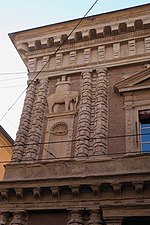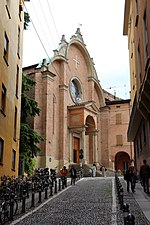Palazzo Davia Bargellini, Bologna
Baroque palaces in ItalyHouses completed in the 17th centuryMuseums in BolognaPalaces in Bologna

The Palazzo Davìa Bargellini is a Baroque style palace located on Strada Maggiore in central Bologna, Italy. It presently hosts the Civic Museum of Industrial art and Davìa Bargellini Gallery, which is an eclectic collection of paintings as well as applied arts and functional ornamentation, described as curiosities of the old Bologna. The diverse applied art collection includes ceramics, liturgical robes, keys, ornamental door knobs, marionettes from street theaters, furniture, iron grille work, elaborately carved wooden frame, and a gilded carriage.
Excerpt from the Wikipedia article Palazzo Davia Bargellini, Bologna (License: CC BY-SA 3.0, Authors, Images).Palazzo Davia Bargellini, Bologna
Strada Maggiore, Bologna Galvani
Geographical coordinates (GPS) Address Nearby Places Show on map
Geographical coordinates (GPS)
| Latitude | Longitude |
|---|---|
| N 44.4923 ° | E 11.3519 ° |
Address
Museo civico d'arte industriale Davia Bargellini
Strada Maggiore 44
40125 Bologna, Galvani
Emilia-Romagna, Italy
Open on Google Maps









